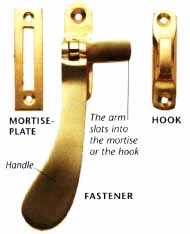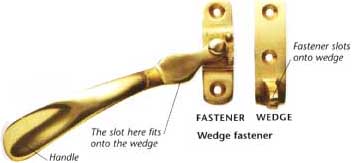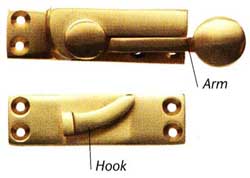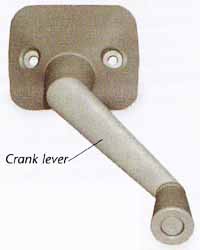Window hardware typically comes with any new window that you purchase, but you can also replace hardware to match renovations or decorations in your home. Polished brass, chrome, antique brass, satin nickel, and oil rubbed bronze are just some of the many types of finishes you can choose from when selecting new window hardware. It is important to read the manufacturer’s instructions on caring for your hardware so that it remains in good condition.
CASEMENT FURNITURE
Choose casement window furniture that will work with your window type and style. There are three main types of casement fastener used to hold windows shut. Stays can either keep a window closed, or can fasten it in an open position to stop it slamming. Both a fastener and stay may be fitted to the same window.
Casement fasteners: A wedge or mortise type fastener is used when a casement closes against the frame, a hook fastener when the closed casement and frame sit flush. Some fastener sets include both mortise and hook options.

Fastener set: The short arm at the end of the fastener
slots into a groove (mortise) cut into the frame, or onto a hook.
MORTISE PLATE; FASTENER: The arm slots into the mortise or the hook;
HOOK.

Wedge fastener: The fastener has an aperture that
slots onto a wedge that's fixed to the window frame. Fastener slots
onto wedge; The slot fits onto the wedge.

Casement stays: Stays are long bars with holes in
them that are fitted to the opening casement of a window. Separate
“pins” are positioned on the window frame. The holes on the stay can
be slotted onto both pins to hold the window tightly closed. Alternatively
any hole can be slotted onto either pin to keep the window open the
desired amount. Sliding stays are a different design that move within
a bracket. A screw mechanism is tightened to hold the casement in the
required position.
SASH FURNITURE
Sash window hardware is designed to allow you to easily lift and lock the window in place. Sash hardware typically includes sash pulls, sash lifts, and locks. Not as common, sash stops can be used on both sides of the window for extra security. Available in a variety of finishes to match your decor, sash hardware typically has fewer moving parts than casement hardware. Shown below are some specialty sash window hardware.
Sash fasteners
These hold the two sliding sections of a sash window together. They all work as two-part mechanisms, with one part fixed to each sash.

Quadrant arm: The arm swings under the hook on the opposite
sash.

Unsprung fastener: A threaded bar is swung into a keep on
the other sash. The bar has a nut on it that's tightened to secure
the bar in place.
CRANK WINDOW HARDWARE
A very popular casement hardware choice is the hand crank hardware. Crank hardware is available in a variety of finishes and even integrated styles that fold away into the window sill, so that they do not stick out while not in use.

Hand crank: Cranks are levers that are attached to
a rotating shaft. Using a rotating motion, the hand crank opens the
casement window to the outside.
FURTHER INFORMATION
If you are renovating an older home and want to match your older hardware on newer windows, there are antique reproduction hardware options available for many types of windows: sash and pulley windows, casement or crank operated, screen and storm windows, as well as shutters and other related hardware. It is possible to make good discoveries at local specialty shops and flea markets, but if you are seeking something in particular, start by searching the Web.